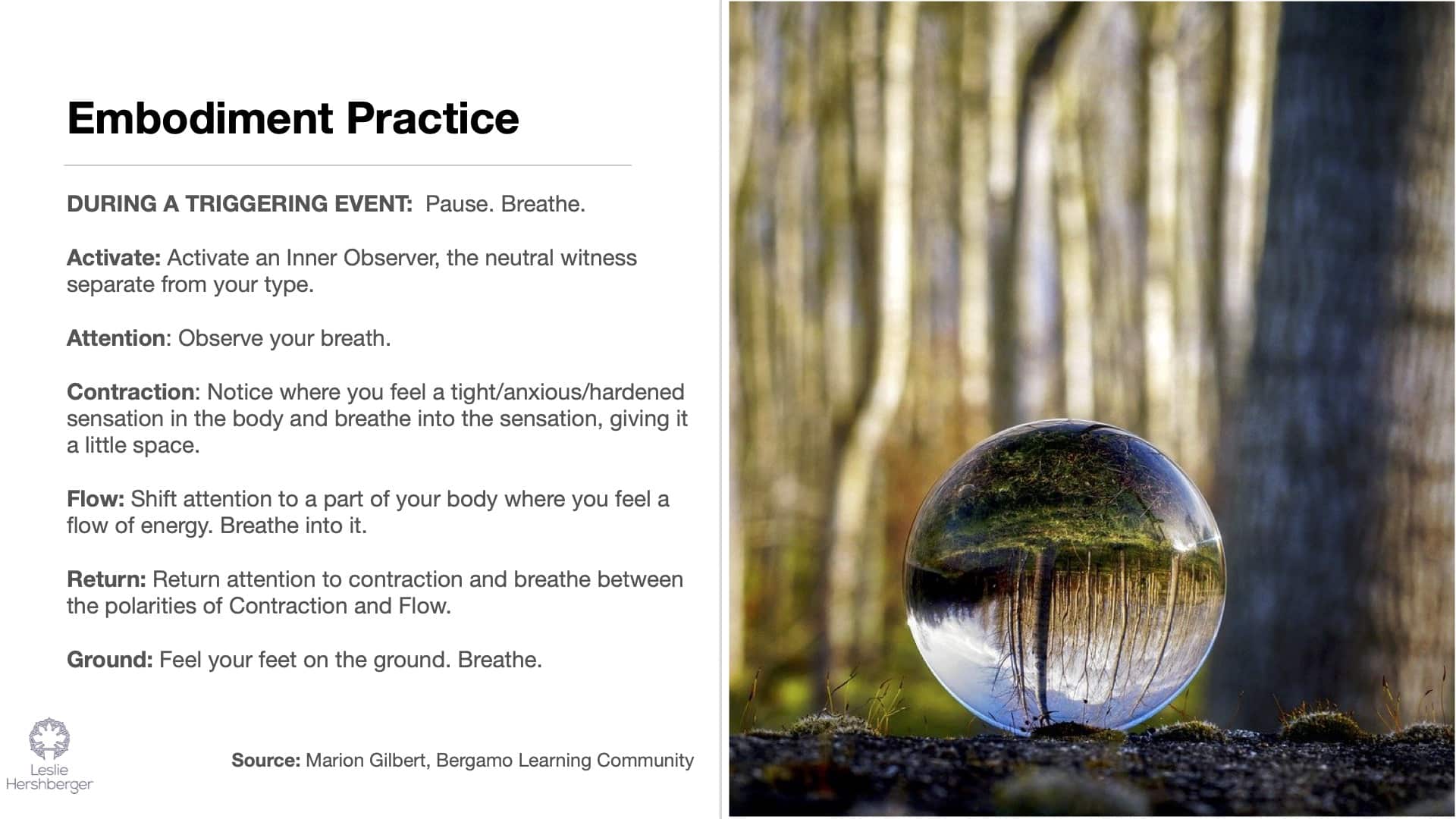We can’t write a prescription based on the arrows for each Enneagram type as in “Enneagram 6 goes to Enneagram 9 in order to be “healthy” or Enneagram 4 needs to “go to” Enneagram 1.” It’s not how it works. We’re too different based on factors like culture, conditioning and family of origin.
Instead, we can learn to manage our INNER STATE on the spot.
.
 This takes practice which includes embodiment. What’s embodiment? It’s learning your physical inner cues and pausing in order to ground yourself enough to do something different. Under pressure we default to the “conditioned tendencies” that live in our bodies.
This takes practice which includes embodiment. What’s embodiment? It’s learning your physical inner cues and pausing in order to ground yourself enough to do something different. Under pressure we default to the “conditioned tendencies” that live in our bodies.
We tighten, we
Knowing our Enneagram type is helpful when things are humming along, but not under pressure.
.
The first step in the PRACTICE of managing our state
At any given time in a day, your are living in a particular state and it impacts how you think, feel and behave. If you’re a 6 and feeling doubtful, you may procrastinate, project and attack. If you’re a 9, you may energetically feel like molasses..stuck and unable to make a move towards self care. If you’re a 3, you may be impatient and unfeeling.
If you’re in a state of calm, grounded presence and openness, the people and situations that were annoying don’t carry a lot of heat for you. You feel some empathy or neutrality. You aren’t managing, judging, fawning and fixing.
These states determine our behavior, and impact people’s respond to us and determine our impact and joy.
Learning to manage your inner state can support conscious action, inner peace and a sense of connectedness.
Begin with self-observation. Witness how your patterns show up in your mental and emotional habits (See my website to find your habits…link in bio). If you’re a 9, you don’t do self-forgetting/numbing like other 9s. One 9 may go for a run as a way to numb, another may zone out on Candy Crush. Each Enneagram 8 plays out excessiveness/impulsivity/scanning for deceptions differently.
A daily practice is important. We’re building capacity to be grounded in 3 centers rather than *react* on automatic. It’s strength training for when the stakes are high.
(I have some free helpful meditations on my site and type related meditations on iTunes)
.
How do I know if I am a healthy version of my Enneagram type?
 While I do know we have healthier expressions of our type, I don’t believe we’re in a perpetual state of “healthiness.” A few 2nd-half-of-life humblings disavow you of such a notion especially under the pressure of these fraught times. (May this free you of the demon of perfectionism towards yourself AND others..another 2nd half of life realization).
While I do know we have healthier expressions of our type, I don’t believe we’re in a perpetual state of “healthiness.” A few 2nd-half-of-life humblings disavow you of such a notion especially under the pressure of these fraught times. (May this free you of the demon of perfectionism towards yourself AND others..another 2nd half of life realization).
Through our practice of self observation, we begin to have an inner felt sense of when we’re grounded in our body, open hearted and clearly thinking like a boat on calm waters on a clear evening.
.
Working with the energy of the arrows

For me, it looks like this: As an Enneagram 7, when under pressure, the pain of cumulative loss is overwhelming. I scatter and over extend by talking my feelings rather than taking time to FEEL them by doing embodiment practices. (Remember, 7s’ core avoidance is pain/limitations).
My head is NOT my friend in this state. When in a contracted state, I’m on the low side of both 4 and 1: feeling misunderstood, overly critical and judgmental with a pinch of martyrdom.
To the degree I can Pause, drop inside and do a Pause practice, I feel the mental clarity/objectivity of an Enneagram 5 at their best and the beautiful feeling of life’s complex richness of 4s at their best.
(You’ll notice there are 4 types that do not have a leg in all 3 centers. Those of us who have worked with the Enneagram for any extended period of time, know that we actually do have a “dotted line” to a type in our missing Enneagram center. David Daniels wrote an outstanding piece on this teaching which is called “The Enneagram of Harmony.”
.
Self inquiry
Ask yourself, how do my Enneagram arrows show up when I’m under stress?
What thoughts, emotions and behaviors do I notice? How do I know I am reactive and behaving on automatic and when I am grounded and present?
What are the high and low side of they types to which I have an arrow?
How do these patterns play out in my life? Get to know your triggers, habitual thought patterns and emotional template.
What practices can I do to shift states from reactive to grounded and present?

